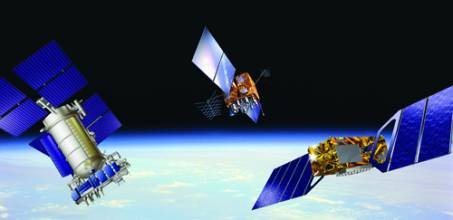Existing GNSS systems use clocks based on microwave radio frequency (RF) standards operating at frequencies of up to 1010 Hz (10 GHz). This article examines the potential improvements and advantages of using clocks based on optical frequency standards, which have much higher natural frequencies of around 5 × 1014 Hz.
In general, high-precision clocks used to provide time in GNSS systems are based on three elements: a reference “frequency standard,” an oscillator, and a counter to count the oscillations.
Existing GNSS systems use clocks based on microwave radio frequency (RF) standards operating at frequencies of up to 1010 Hz (10 GHz). This article examines the potential improvements and advantages of using clocks based on optical frequency standards, which have much higher natural frequencies of around 5 × 1014 Hz.
In general, high-precision clocks used to provide time in GNSS systems are based on three elements: a reference “frequency standard,” an oscillator, and a counter to count the oscillations.
Over the last two decades, the stability and accuracy of optical frequency standards based on trapped ions and atoms have improved to a point where their performance now exceeds that of microwave standards. (The articles by P. Gill listed in the Additional Resources section provide a good introduction to the principles and current state of optical clock design.)
The photograph above shows an example of a UK National Physical Laboratory (NPL) strontium ion end cap trap. By trapping a single strontium ion and laser cooling it to a few milli-Kelvin, the 674-nanometer “clock transition” can be interrogated using an ultra-narrow and stable (Hz-level) laser, which provides the optical oscillator.
The laser in these optical oscillators is stabilized by locking it to a special vibration-insensitive cavity made of ultra-low expansion (ULE) glass.
The last element of any clock is a counter. The development over the last decade of a special optical frequency measurement system known as an “optical frequency comb” has made possible the practical realization of optical clocks. Based on octave-spanning, femtosecond mode-locked lasers, such frequency combs can relate different stable optical frequencies with each other and with microwave frequencies with unprecedented relative frequency accuracy at the level of up to a part in 1019.
Ultimately, optical clocks will offer accuracies and stabilities at the level of a part in 1017 or better. Such devices are likely to find both terrestrial and space applications, in scientific and environmental fields as well as navigation. Eventually, the second will probably be redefined in terms of an optical reference, rather than the current standard of a 9.2 GHz cesium hyperfine transition.
. . .
Summary
Satellite clock prediction accuracy may be considerably improved with the emerging optical clock technology. To maximize the performance benefits, optical clocks should be placed onboard the satellites (and on ground to generate the system time).
Implementation of optical clocks to keep the system time could increase the accuracy of Galileo timing service (dissemination of UTC) and keep the UTC prediction function within the system. In this case, dependence on an external infrastructure such as the TSP may be reduced.
If other contributions to the error budget (mainly, the multipath) were reduced, we might anticipate further significant benefits to user positioning accuracy from improved clock technology, for instance, through exploitation of carrier phase techniques.
Placing better clocks on satellites will reduce the need for frequent updates, which will simplify the requirements on ground systems and also reduce costs. If update links were to fail for a significant amount of time, having very good clocks in the space segment would reduce the rate of degradation of the service to users on the ground.
Additional Resources
[1] Gill, P., “Optical frequency standards,” Metrologia, 42 S125, 2005
[2] Gill, P., and H. Margolis, “Optical clocks,” Physics World, May 2005
For the complete article, including figures and graphs, please download the PDF at the top of the page.
Issue Home






